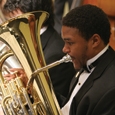A thorough discussion of the euphonium’s intonation problems, along with their possible solutions is a lengthy and complex undertaking. Such a discussion involves an examination of several interrelated factors common to all brass instruments, especially those with valves. Instrument manufacturer and design considerations, the concept of compromise tuning, the individual player’s intonation tendencies, mouthpiece size, temperature, and several other variables are a part of this complexity. Running throughout this entire discussion is a thread of logic and related ideas that will enable both teachers and performers to handle the problems in a knowledgeable and confident manner. The intent of this article is to condense as much information as possible into simpler concepts – information that can be filed away in the immediate memory and used on recall. The more a performer knows about the intonation tendencies of the euphonium, whether a student or experienced teacher, the more easily he can deal with day to day tuning problems. It is much easier to react quickly and confidently when knowing what to expect in a given situation.
One of the first concepts a teacher or performer must understand is that of compromise tuning. Instrument manufacturers are faced with the fact that intonation on all brass instruments is inherently imperfect. They can only try to minimize or balance out the tuning problems. In designing an instrument, the maker has to decide how sharp he can allow a given note to be, realizing that if he lowers it any more he will make some other note too flat. Problems of this type fall into two basic categories: natural overtone series discrepancies and valve combination discrepancies.
Overtone Series Discrepancies
The overtone series, also known as the harmonic series, can best be defined as the various frequencies, from lowest to highest, that may be generated in a given length of tubing. The overtone series for euphonium displays the characteristic pattern of intervals that is common to all the other brasses: the octave, perfect 5th, perfect 4th, major 3rd, minor 3rd, minor 3rd, and major 2nd, etc.
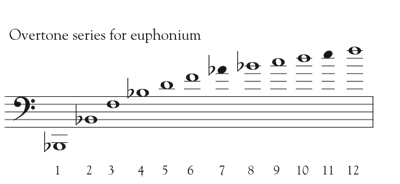
The first note or partial is the fundamental and is also referred to as a pedal tone. The second note is the second partial as well as the first overtone. Because the notes of an overtone series are derived from laws of physics, various frequencies do not agree exactly with our man-made system of equal temperament, the division of the octave into twelve equal parts. When compared with equal temperament, the following results are obtained: Partials 1, 2, 4, and 8 are in tune with each other and coincide with equal temperament (all Bbs). Partials 3, 6, 9, and 12 are sharp to varying degrees (F’s and high C). Partials 5, 7, 10, and 11 are flat to varying degrees (Ds, Ab, and E).
Because the bulk of the euphonium’s standard playing range falls between partials 1 and 8, a performer can simplify and condense this information: Partials 1, 2, 4, and 8 (all Bbs) are in tune. Partials 3 and 6 (Fs) are sharp. Partials 5 and 7 (D and Ab) are flat. Of these, partial 3 is so slightly sharp it can be corrected easily by the embouchure, while partial 7 is too flat to be used. This leaves only partial 5 (moderately flat) and partial 6 (noticeably sharp) that are of concern.
It is helpful to remember that the partials are out of tune to a degree that corresponds to their numerical order: partial 3 is the least out of tune, followed in order by partials 5, 6, and finally 7.
Harmonic Modes
Another term needs to be defined in order to grasp the implications of the out-of-tune partials. A harmonic mode results from the lowering of any open tone chromatically through the normal descending chromatic valve sequence.
Each note of the harmonic mode is the respective 4th partial of that valve setting’s overtone series. For example, the G is the 4th partial of the 1-2 overtone series. Each note in a given harmonic mode assumes the same intonation characteristic as the open valve note because they are all derived from the same respective partial.

Valve Combination Discrepancies
The second major area of inherent tuning problems on the euphonium is that of valve combination discrepancies. Manufacturers of valved instruments have long wrestled with the problem of compromise tuning. They know that they can make the separate valve slides the correct length to lower each valve an exact amount. The second valve slide lowers the open tone one-half step, the first valve slide lowers a whole step, and the third valve slide lowers the open horn one and one-half steps. It is not until the valves are used in combination that serious intonation problems begin to surface – problems of proportionate tubing length. If one starts with a longer piece of tubing than the open horn (perhaps with the second valve already down) it will obviously take a longer length of tubing to lower the pitch a given amount (perhaps another whole step). If it takes four percent of the total tube length to lower the pitch a whole step, four percent of a longer tube (with the second valve down) is more than four percent of a shorter one (the open instrument). Therefore, we continually come up short of tubing when using the valves in combination. The upper table (from Earle L. Kent’s The Inside Story of Brass Instruments, Conn, 1956) shows valve slide length examples chosen to give correct intonation when used individually.
The sharpness of all the combinations is readily evident: 1-3 is almost a third of a semitone sharp and 1-2-3 is slightly more than a quarter step sharp. Faced with this physics problem, instrument manufacturers resort to the idea of compromise tuning as a partial solution. This tuning is accomplished by purposely making the various valve slides longer than they need to be. Depending on the manufacturer the first and second valve slides may be lengthened slightly, while the third valve slide is always made longer. Because this valve is seldom used by itself, it can be made purposely quite flat in an effort to lower the sharp 1-3 and 1-2-3 combinations. The lower table, also from The Inside Story of Brass Instruments, shows valve slide length examples chosen to give slide compromise intonation.
The compromise tuning should be evident. Each of the individual slides are tuned lower (an almost negligible amount in the case of the first and second valves) to take some but not all of the sharpness out of 1-2, 1-3, and 1-2-3, but in doing this 2-3 becomes flat. No matter how each manufacturer goes about designing a three-valved instrument, he must still deal with this basic and inherent problem.
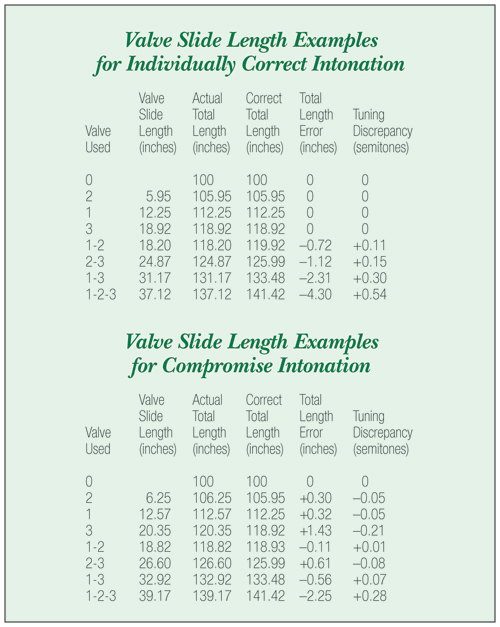
Cumulative Effect
In some cases the natural tendencies of valve combination discrepancies and harmonic mode discrepancies may be opposite and therefore offset each other. This phenomenon is illustrated in the cumulative effect shown in the 3rd and 5th harmonic modes.
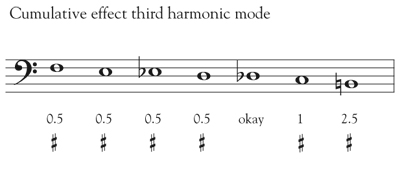
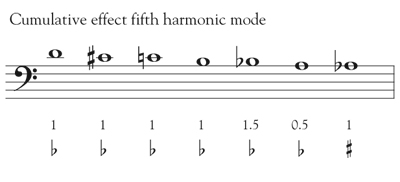
Assuming that degree is merely a relative term of measurement, the third harmonic mode (example 5) could be described as a one-half degree sharp harmonic mode. We can assume a negligible first valve, second valve, and 1-2 combination valve slide length error; a one-half degree flat 2-3 fingering combination error; a one-half degree sharp 1-3 fingering combination error; and a two degree sharp 1-2-3 combination error. The resultant numbers display the negating or compounding effect of the two inherent intonation variables. In example 6 assume a one-degree flat harmonic mode with the same valve error factors as above.
Although these inherent tuning problems are of prime concern, there are obviously several other factors that influence intonation. Mechanical tuning devices, the addition of a fourth valve, compensating valve systems, environmental temperature, mouthpiece and instrument design, and various physical considerations relating to lips, teeth, tongue, and air speed all have their effect on intonation.
An Added Fourth Valve
Through the years a number of attempts have been made to design adjustable kickslides for the three-valved baritone or euphonium similar to those found on the cornet and trumpet. Such devices were usually attached to the main tuning slide and were often spring-loaded in some manner. None have been widely accepted, perhaps because they proved too awkward to use. Because a truly successful system was never adopted, there are countless three-valved baritones in use in the public schools today that are impossible to play in tune. C3 and B2 are two of the most common intonation problems on these three-valved instruments. The notes are extremely sharp and players can either lip them down, manually pull the third valve slide, or do both. Because pulling the slide while playing is difficult to accomplish (if not impossible on the typical school instrument), players are left with little choice other than to lip down as best as possible.
Fortunately, adding a fourth valve to the instrument is another solution to this particular problem. This valve lowers the open instrument a fourth, making it an interchangeable fingering for 1-3. Because it is independent of the other three valves, the fourth valve slide can be set to sufficient length to play C3 in tune. Similarly, the B2 may be played 2-4 rather than 1-2-3. Extending the lower register is another benefit of the additional valve. Because the fourth valve lowers the fundamental a fourth to F2, a new overtone series is created along with a new set of harmonic modes. The following example shows the harmonic mode that bridges the gap chromatically from E2 to the pedal Bb1.
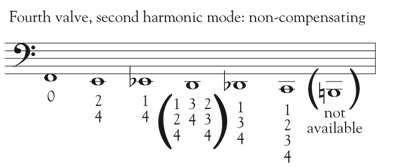
Here again there are problems with the proportionate tubing length rationale — the notes become sharper as the player proceeds downward through the fingerings. By the time a euphoniumist reaches the D2 on a non-compensating four-valved instrument, he will likely have had to try three fingerings, each flatter than the preceding one, before the pitch is lowered enough for correct intonation. The Db2 usually requires a 1-3-4 fingering and the C2 a 1-2-3-4 fingering, leaving no additional tubing for the B1.
Compensating Valve System
The compensating valve system available on some euphoniums offers a practical solution to the intonation problem by adding small knuckles of tubing to each of the valves. This extra tubing comes into play only when valves are used in combination, lowering the pitch when needed and enabling the player to use the normal descending chromatic valve sequence down through B1.
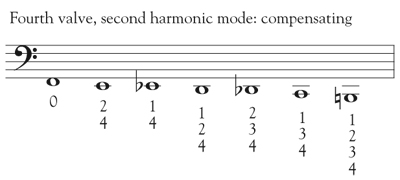
Temperature
The effect of temperature on the pitch of the euphonium needs little explanation to those who have marched at halftime on a Friday night in November or sat on the concert stage under blazing lights in April. All brass instruments sharpen as the temperature rises, and flatten as it cools. This phenomenon occurs because sound waves travel faster through warmer, less dense air. They strike the ear at a faster rate, and the listener perceives them as a higher frequency. Students sometimes attempt to explain the sharping phenomenon by arguing that the rise in temperature causes the molecules of the instrument to agitate, resulting in an expansion of the instrument’s metal. A little logical thought should convince students that an expanded (larger) instrument would produce a lower sound, not a higher one.
Mouthpiece and Instrument Design
Mouthpiece and instrument design also influence intonation. In mouthpieces, cup volume is the most important consideration – the greater the volume, the flatter the pitch. The size of the throat opening and the size and shape of the backbore also interact to influence intonation. In designing an instrument, the manufacturer may raise the flat fifth partial or lower the sharp sixth partial, but the inherent proportionate difference must remain the same. Another manufacturer may flatten individual valves more than another, but the relationship between individual valves and valves used in combination remains the same. In either situation the inevitable reality is compromise. The maker of fine instruments will have achieved as careful and controlled balance when making compromises for good intonation.
Physical Considerations
Various physical considerations also influence the tuning, though usually to only a moderate degree. All euphonium players must lip up or down, and they soon learn that it is generally easier to lip down than up. Obviously one can lip only so far before the tone quality is adversely affected, making this technique best suited for small pitch adjustments. Larger pitch adjustments should be approached first through carefully tuning the main tuning slide and/or using alternate fingerings. Other factors which may be used to make small adjustments in pitch include opening the teeth or dropping the jaw (the more open, the more tendency to lower the pitch), changing the tongue position (arching more into an ee syllable tends to raise the pitch slightly), and varying the air speed (the euphonium overblows sharp and undersupports flat).
Vibrato and Mutes
Vibrato and mutes also affect tuning. The most commonly used and (in my opinion) the only satisfactory method of producing vibrato on the euphonium is the lip-jaw vibrato. The slight and controlled up and down motion of the jaw and lower lip (ya-ya-ya-ya) as the tone is sustained will alternately lower and raise the pitch from center to slightly below center and back to center (or perhaps even slightly above center). Done in moderation and with regard to stylistic appropriateness, this pleasant bending of the tone enhances and warms the instrument’s sound.
More and more contemporary solo and large ensemble literature calls for the use of a straight mute for the euphonium. Players should be aware that these mutes generally tend to sharpen the pitch.
Improving Intonation
In the beginning stages of a student’s training, encourage the buzzing of various interval patterns on the mouthpiece alone. Let young players buzz familiar tunes, scales, or other patterns that encourage selectivity and accuracy of pitch from the very start. When they attempt to reproduce pitches on the instrument, they should find it easier to center the pitch more accurately.
There is no substitute for teaching fundamentals in the first months of a student’s experience with the euphonium. Young players must develop concepts of correct embouchure and proper breath (tonal) support. If there are no major problems with embouchure and the use of the air stream, students and teachers can expect the euphonium to react predictably with regard to intonation.
In later stages of development, the teacher should stress listening and matching pitches on a regular basis. One of the best opportunities to encourage this careful listening on a consistent day-to-day basis is in the warmup period, either in a group or individually. Directors of large ensembles should devote 10-15 minutes of each rehearsal (if time allows) to let students warm up on long tones, lip slurs, scales, unison studies, or chorales for the express purpose of balancing, blending, and matching pitch. The private teacher should encourage a similar warm up and occasionally play along with the student to provide a pitch standard and encourage more discriminate listening.
Directors should also devote an occasional section rehearsal to a lecture-demonstration on intonation to let the euphoniumists hear beats and make necessary corrections. This is the ideal time to sort out and correct intonation problems within the immediate section.
Once the player has achieved some maturity and stability in tonal production, he should be encouraged to spend some time in front of an electronic tuner and make out an intonation tendency chart. The procedure consists of writing out the chromatic scale for the basic range of the euphonium and then notating whether each tone tends to be sharp or flat. An arrow pointing up or down over the note could indicate sharpness or flatness and the length or size of the arrow could indicate the degree of the tuning problem. If this procedure is repeated several times with a degree of consistency, the student should see clearly emerging tendencies in playing certain notes out of tune, with his personal set of variables (embouchure, air usage, mouthpiece, instrument, etc.). Once the student understands and identifies the problem, the correction process becomes much easier.
Summary
Clearly a discussion of intonation problems in any depth is destined to be lengthy. The many factors that influence tuning are complexly interrelated, yet most can be distilled into a few easily remembered facts once the concepts are understood:
• There are a handful of notes that are out of tune because they belong to an out of tune 5th or 6th partial
• There are a handful of notes that are habitually out of tune because they are played with valve combinations that are predictably sharp or flat
• There is a cumulative effect resulting from the interaction of the out-of-tune partials and the out-of-tune fingering combinations
• The fourth valve eliminates a major tuning problem in that it can substitute for the quite sharp 1-3 combination
• The compensating valve system on a four-valved instrument allows the notes from E2 down to pedal Bb to be played with the normal fingerings
• Temperature, various physical considerations, even vibrato and the use of mutes affect pitch moderately and in a generally predictable manner.
If a student hears pitch reasonably well, conscientiously tries to play in tune, produces the tone correctly, and has a reasonably well-made instrument that is in tune with itself, there are only a few notes that usually cause a large percentage of the tuning problems on the euphonium.
G3 is often sharp in 1-2 and can be lowered by substituting third valve. D3, C3, and B2 are habitually sharp. The use of the third valve substituting for 1-2 on D3, the fourth valve for C3, and 2-4 for B2 usually corrects these troublesome notes. The next three tones (D4, C#4, and C4) are usually flat because they are all 5th partial notes. Similarly, F4, E4, and Eb4 are always sharp because they are all 6th partial notes. Alternate fingerings should be tried on all these notes until the best intonation is obtained. The F4, E4, and Eb4 can be lowered on some four-valved compensating system euphoniums by adding the fourth valve. The final five upper register notes may be fingered as marked if they are too flat in their normal fingerings.
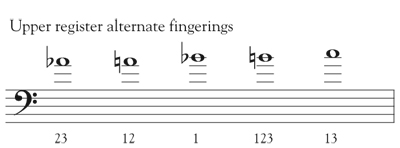
Musicians will never eliminate intonation problems from their playing. However, an effort to understand the reasons tor basic tuning problems can lead to marked improvement. No player or teacher should be ignorant about how to achieve good intonation. There are solutions to the problems; we need only understand, listen, and apply what we know.
